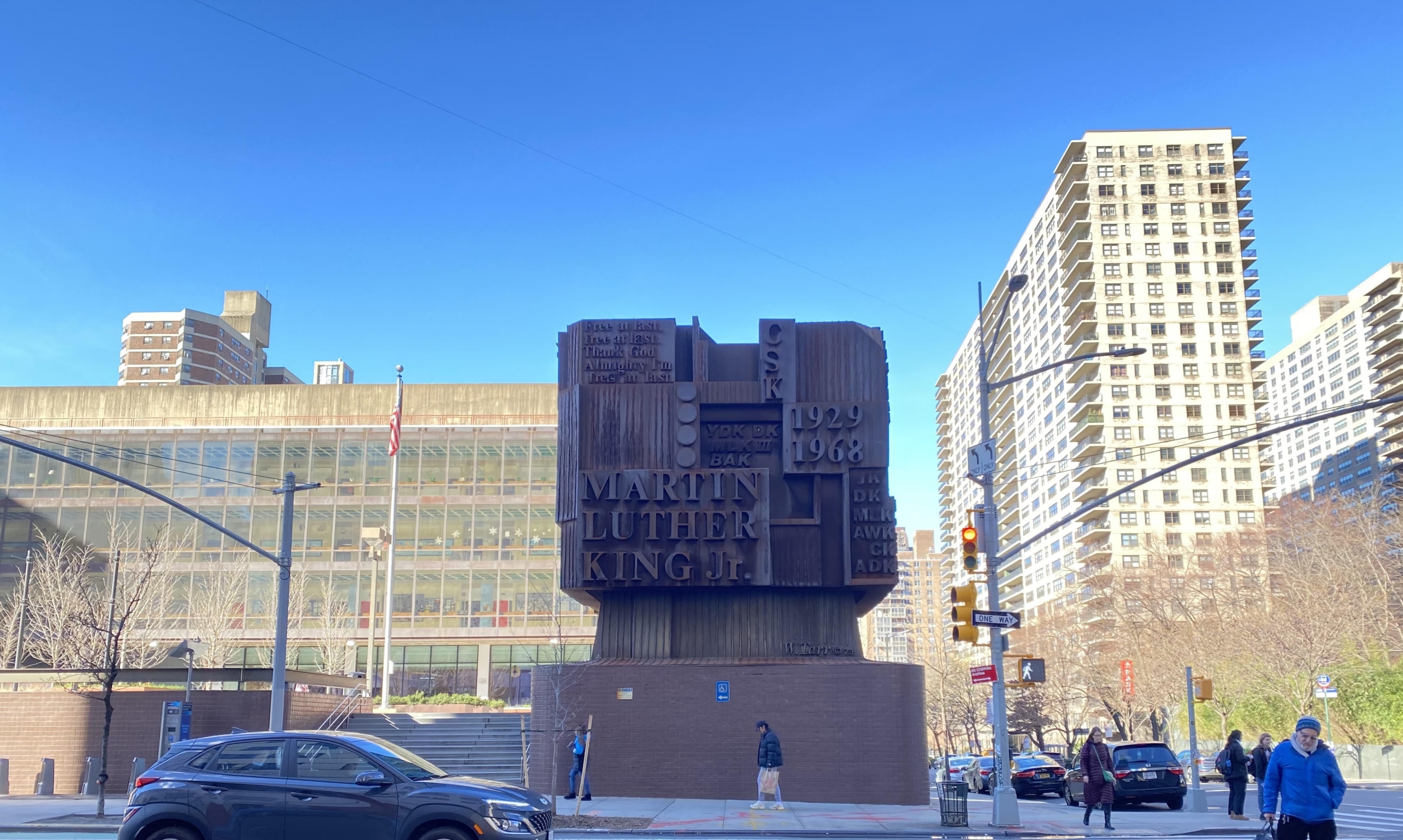
Text and Photographs by Leigh Hallingby
The Upper West Side is home to New York City’s most prominent sculpture honoring Dr. Martin Luther King Jr. Last year, 2023, marked 50 years that it has been standing at the corner of West 66th Street and Amsterdam Avenue, outside the Martin Luther King Jr. Educational Campus, which houses six small public high schools.
Commissioned by the city’s Board of Education, the sculpture is by William Tarr (1925-2006), who also created “Gates of Hell” for the U.S. Holocaust Memorial Museum in Washington, DC. The Martin Luther King Jr. Memorial is a large cube, 30 feet on each side, made of self-weathering steel and built around the central intake unit for the schools’ heating, ventilation, and air conditioning system.
This most unusual and complicated sculpture does not include an image of Dr. King, but does have lots of text about him and his life. The work has been referred to as a biography of Dr. King. However, passersby consistently report that they do not understand the meaning of all the information on the artwork. As both a licensed New York City tour guide and someone who lives across the street from the monument, I decided to make it a professional and a personal project to demystify and understand it. I was helped greatly in this process by having lived through the civil rights movement in real time; having taken a civil rights tour in Georgia and Alabama in January 2020; reading a major new biography King: A Life, by Jonathan Eig (2023); contacting helpful staff at the school; and finding numerous useful sites on the Internet. This is what I discovered.
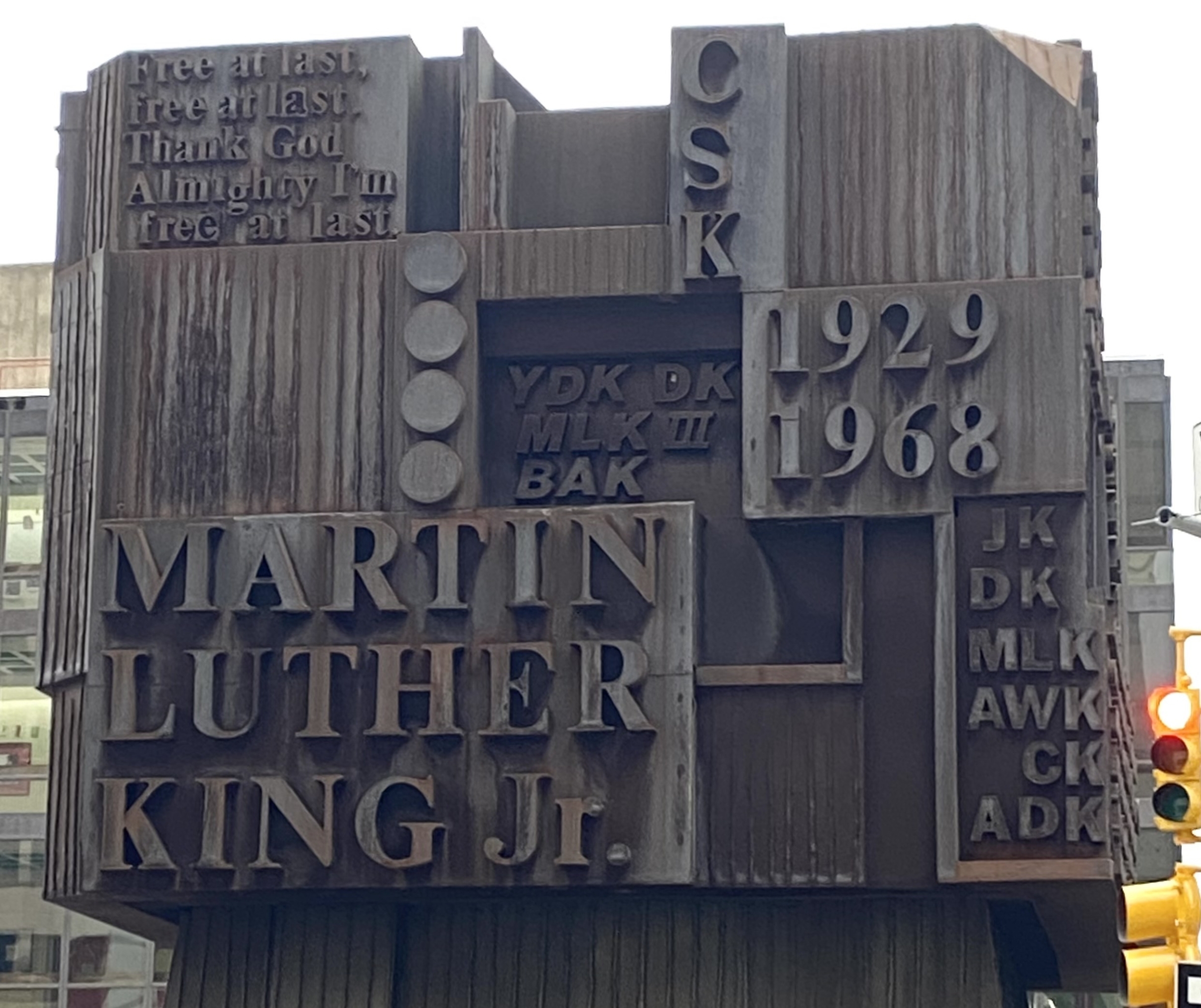
On the east side (pictured above) is the title of the work, Martin Luther King Jr. There are also initials of the members of the King family: Dr. King’s wife Coretta Scott King; the four King children, Yolanda Denise, Dexter, Martin Luther III, and Bernice Albertine; Dr. King’s paternal grandparents, James and Delia; his parents, Martin Luther Sr. and Alberta Williams; and his siblings, Christine and Alfred Daniel. Also included on this side are Dr. King’s birth and death dates: 1929–1968. And there is a quote, as there is on each side, from Dr. King: “Free at last, free at last. Thank God Almighty I’m free at last.” Dr. King delivered these immortal words on the steps of the Lincoln Memorial on August 28, 1963, as part of his iconic “I Have a Dream” speech during the March on Washington for Jobs and Freedom.
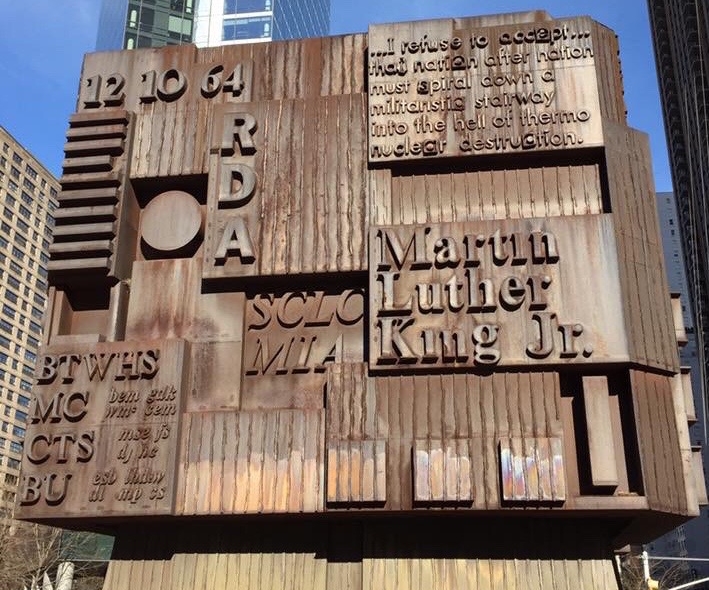
Moving clockwise, the south side comes next. It focuses on Dr. King’s education and his work in the civil rights movement. On the lower left are the initials of the schools that Dr. King attended: Booker T. Washington High School in Atlanta; Morehouse College in Atlanta; Crozer Theological Seminary in Upland, PA; and Boston University. There are lower case initials of the people who were his most important teachers, professors, and friends at these institutions.
In the middle of this side, we see the initials SCLC for Southern Christian Leadership Conference, founded in 1957 in Atlanta. MIA is the Montgomery Improvement Association, which was instrumental in guiding the Montgomery bus boycott from 1955-56. This foundational event in the civil rights movement catapulted Dr. King into the national spotlight. RDA is Ralph David Abernathy, probably Dr. King’s closest friend and mentor. The date of December 10, 1964 in the upper left corner is when Dr. King was presented with the Nobel Peace Prize in Oslo, Norway, for his work in the civil rights movement. On the upper right-hand side is a quotation from Dr. King’s Nobel acceptance speech: “I refuse to accept the cynical notion that nation after nation must spiral down a militaristic stairway into the hell of thermonuclear destruction.”
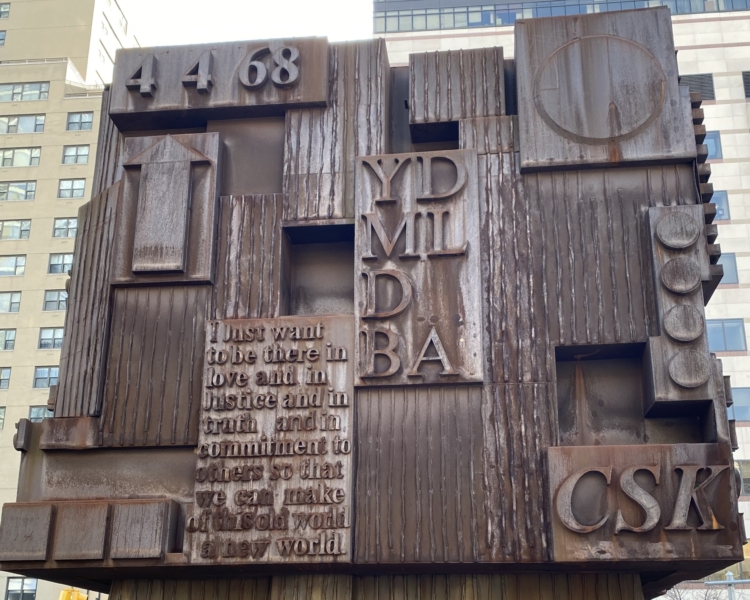
The west side focuses on Dr. King’s death. The date in the upper left corner, 4-4-68, represents the assassination of Dr. King in Memphis, TN. The initials of Dr. King’s wife and children are repeated here, probably because these were the people most likely to carry on his legacy. The quotation in the middle at the bottom reads: “I just want to be there in love and in justice and in truth and in commitment to others, so that we can make of this old world a new world.” Dr. King spoke those words at the Ebenezer Baptist Church in Atlanta, on February 4, 1968, as part of his last sermon there, exactly two months before his death. At his widow’s request, a recording of this sermon was played at the funeral.
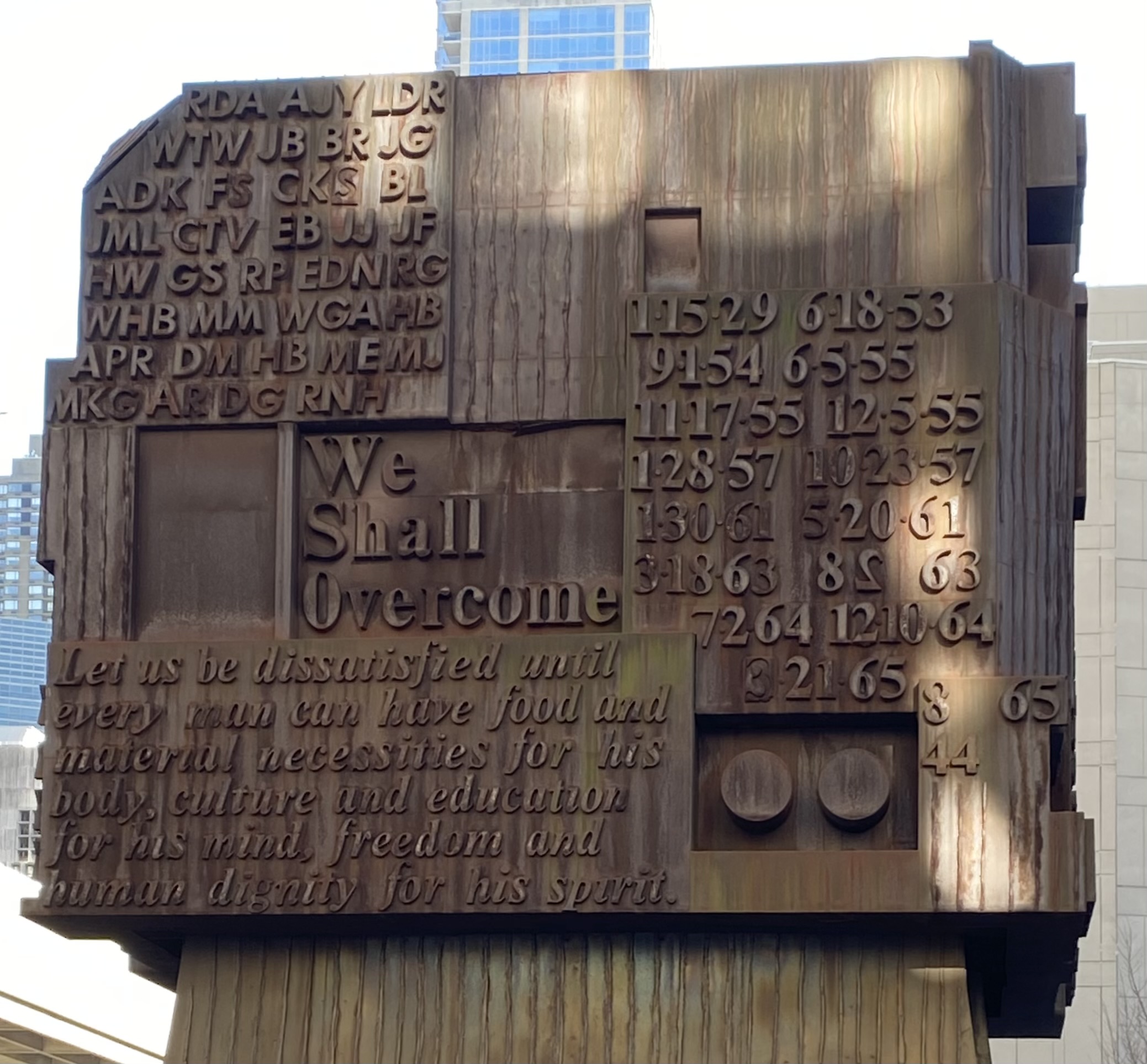
Finally, there is the most complicated side, the north side of the memorial. It requires the most decoding, other than the words “We Shall Overcome,” the song that became the anthem of the civil rights movement. In the upper left are 34 sets of initials, many of them important colleagues of Dr. King. For instance, the list includes A. Philip Randolph and Bayard Rustin, the men who planned the 1963 March on Washington. Also, Ella Baker who worked, mostly behind the scenes, mentoring many emerging activists. One of the most interesting people on this list is Mahatma Gandhi, whose use of non-violent civil rights protest had a huge influence on Dr. King.
On the right side are 17 important dates in Dr. King’s life. Included are his birth and marriage dates, the births of his four children, and important dates in the civil rights movement. The number 44 at the bottom of the list was actually the most difficult piece of information on the monument to decode, because it does not look like the other dates. It refers to Dr. King’s death date, as April 4 can be abbreviated 4-4. But why is it written like this? I finally realized that 44 actually is also the age that Dr. King would have been when this monument was erected in 1973. Interestingly, over the 50 years since this monument was installed, 44 has taken on yet another meaning related to civil rights, as Barack Obama was the 44th president of the United States
Finally on the north side are these words from Dr. King: “Let us be dissatisfied until every man can have food and material necessities for his body, culture and education for his mind, and human dignity for his spirit.” These were part of a speech Dr. King delivered at Carnegie Hall in New York City, on February 23, 1968, about six weeks before he died, to honor the 100th anniversary of the birth of W. E. B. Du Bois, the American sociologist and civil rights activist.
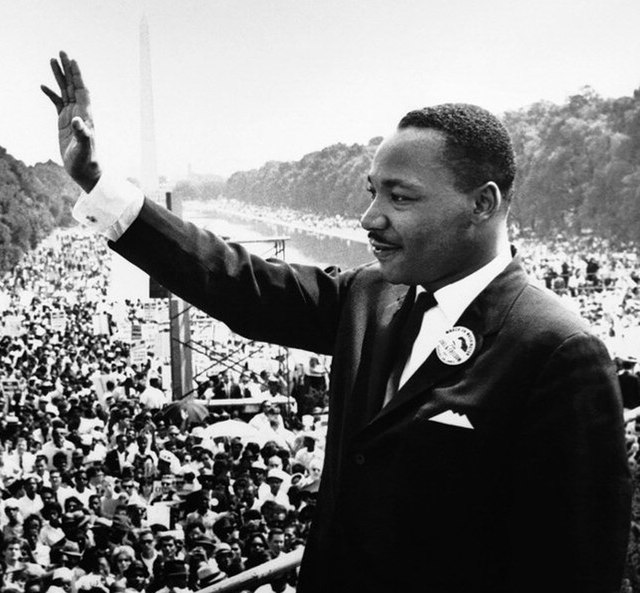
So, ultimately, what are we to make of this sculpture? Can the Martin Luther King memorial, which is so challenging to decipher and which passersby consistently say does not engage them, be considered successful? Or is it best viewed as a truly inventive, but perhaps unsuccessful, artistic experiment in honoring a great American? Or something else? I would love to hear what you think in the comments. You can also email me at lhallingby@gmail.com.
Subscribe to WSR’s free email newsletter here.




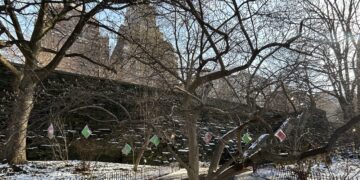




Thank you for decoding this sculpture that I have walked by many times over the past few decades. As many New Yorkers, I am usually walking quickly, so I must admit I have never even walked all the way around this cube (shame on me), so your photos were informative.
Yes, thanks for your well researched article. I too have passed it many times and didn’t know if was meant as a memorial. I thought of it as signage for the school behind it. Was there a dedication in ’73? If you haven’t yet seen it, don’t miss the MLK memorial in Washington, one of the most powerful on the Mall.
Fascinating! Thank you for this.
Wonderful information, makes the monument even more satisfying to study. Now we can all be better tour guides in our own neighborhood. Thanks for taking the trouble to track all this down.
I remember when that school opened. I also vividly remember bringing home a bad report from private school and my father threatening me, “Get your grades up or you will be going around the corner to Martin Luther King”. Back then public school in NYC was a fate worse than death especially MLK.
Not if you got into one of the Specialized Public High Schools.
True. I went to pubic school back then. I t was abysmal.
Thank you Leigh and WSR – this was a perfect article for this day. Honors Dr King, draws attention to an overlooked gem in the neighborhood, and unlocks a complicated set of riddles. Can’t stop smiling! TY again
Maybe the artist intended that the viewer would have to work to fully understand this massive sculpture. Gathering information and sharing it with others are important tasks and, it seems to me, always worthwhile. But it is not hard to understand the well-chosen quotations and to at least think of MLK when you look at (not just see) this sculpture. Thank you for taking the time and putting in the effort to share with all of us what you learned.
Thank you for this. I love this sculpture and I think it is very successful because with it one cannot be a passive observer. You have to engage with the sculpture to understand it fully. I think Dr. King would have liked that. We have to engage to make the world a better place for all.
Thank you so much for deciphering this! I walk by this so often and have always wondered what all the cryptic bits meant. No, it’s not beautiful, but it’s powerful. It makes us be curious and want to learn more. I’m grateful for your hard work! I may have to print this out and bring it with me for the next time I pass by. I wonder if the site would allow explanatory plaques? I’m sure many of the local school kids would appreciate it. : )
Excellent point, it should have explanatory information.
Thank you for this full explanation! I have often paused to look at this, and could figure out a thing or two – some initials, some dates. It is truly a work that tries to point to so much about the man and his life: family, education, colleagues, civil rights history. So much is there. Sadly nearly all of it is completely lost on the average viewer. I wonder if whoever has jurisdiction over the site and the work would consider putting four panels of your “explainers” somewhere discreetly under each of the four sides of the work. For those willing to walk up and read for 4 minutes, the information really fills out this appropriately massive and important testimonial to a giant of our history.
This is great, Leigh. Thanks.
I have to believe that the lines, circles, arrows, and other shapes may have deeper meanings that only William Tarr would know.
I would not say that the monument is beautiful. It’s rather dark and imposing, but I do think it works as a tribute to a great and complicated man.
I have walked by this sculpture so many times since we moved to the UWS and I had one child going to LaGuardia. I thought it was signage for the school and not a memorial to Martin Luther King. Thank you for explaining it’s meaning. It would be wonderful if that could be placed somewhere so others could also understand it’s meaning.
Perhaps they can put a plack explaining the parts of the sculpture next to it which they do in the museums. Simple fix. I found the information in the article interesting. I walked by the sculpture and wondered what the meaning of the different letters and numbers represented. Good article, thank you.
The wonderful thing about this work is that it makes you engage your mind and think about what all the abbreviations and dates mean. And if you get to tired of that, you’re able to ponder the quotes. I think this—a work intended to engage the mind—is so much more valuable than a purely portrait-based sculpture.
Excellent article. Like others in the neighborhood, I’ve passed this sculpture so many times and never knew any of this. Frankly, I wonder if any of the students at these high schools know the details behind the sculpture either. Article should be reprinted and distributed to the students. Should be required reading.
I like how unsentimental the monument is, adorned by facts, not feelings that echos his statement about America should be a true as it is on paper and the use of language as a vehicle of nonviolence. And I like that it’s brown and therefore racially ambiguous. It’s up to us to build onto it, as a squat pillar, but very sturdy.
For all its good intention, why did the monument have to be so brutalist? Was there some method to this madness? You’d think such a revered figure would deserve a monument more dignified than this eyesore.
I was interested to learn that the sculpture’s form was also functional , “…built around the central intake unit for the schools’ heating, ventilation, and air conditioning system.”
Landmark West’s website has an informative description of the architectural history of MLK High School erected between 1969-1975. In summary “The protective aura which surrounds the buildings rises from a 1960s movement to transform schools into ‘fortified strongholds,’ to serve as refuge from dangerous city slums.”
https://www.landmarkwest.org/building/122-amsterdam-avenue-between-65th-and-66th-streets-martin-luther-king-jr-high-school/
This is a great article – very helpful.
The sculpture appears as a three-dimensional puzzle which you have converted to concise and interesting prose accurately reflecting the life of MLK. You have made some very astute connections. If the artist were alive, he would surely appreciate the time and thought you put into this article. The first photo shows the sculpture in context. It fits the site very well and echoes the shape of the school building. What a clever way of concealing the school’s HVAC equipment! Congratulations on your successful article and congratulations to William Tarr on a successful sculpture.
It would be amazing for this information to be readily available near the sculpture to provide the insights to everyone.